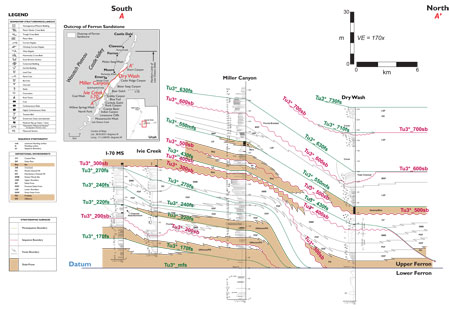Chronostratigraphy of Phanerozoic Depositional Sequences
By:
John W. Snedden
ExxonMobil
| When: | Friday, February 25, 2011, 10:30 a.m. to 11:30 a.m. Join us for coffee beginning at 10:00 a.m. |
| Where: | Seminar Conference Room, 10100 Burnet Road, Bldg 196-ROC, Austin, Texas 78758 |
| Host: | Mead Allison, UTIG |

Abstract
Among the goals of ongoing sea-level research is testing the synchrony of sequence-bounding unconformities (e.g. K. Miller, JOIDES Journal, 2002). Early critics of various sea-level charts argued, with good reason, that chronostratigraphic resolution was insufficient to demonstrate global or even large regional synchronous sequence development.
Recent improvements in biostratigraphy and other age-constraining techniques make this argument less valid today. However, there still exists a large diversity in chronostratigraphic designations of depositional sequences that impedes a direct comparison of various stratigraphic frameworks.
We have developed and used a chronostratigraphic designation system (CDS) within ExxonMobil for a decade, and this has facilitated local, regional, and basinal correlations in the global search for conventional and unconventional hydrocarbon resources. The methodology of this relatively simple CDS is described and application in a broad range of cases illustrated. A compilation of recommended designations for Phanerozoic depositional sequences, along with previously published sea-level and coastal onlap curves has been posted to AAPG Search and Discovery.*
At the very least, adoption of a uniform chronostratigraphic designation system like this will reduce stratigraphic confusion and facilitate communication within a company, between institutions, as well as among academic investigators. We also anticipate benefits in: 1) promoting more effective use of biostratigraphic and other age-constraining data; 2) improved "source to sink" investigation of ancient linked depositional systems; 3) enhanced basin modeling, timing of diagenesis and tectonic deformation in both mature and frontier areas; and 4) supporting robust tests of global synchrony, particularly in "greenhouse" geologic timeframes, where glacio-eustasy obviously plays a lesser role in sequence development.
*(http://www.searchanddiscovery.com/documents/2010/40594snedden/ndx_snedden.pdf)




